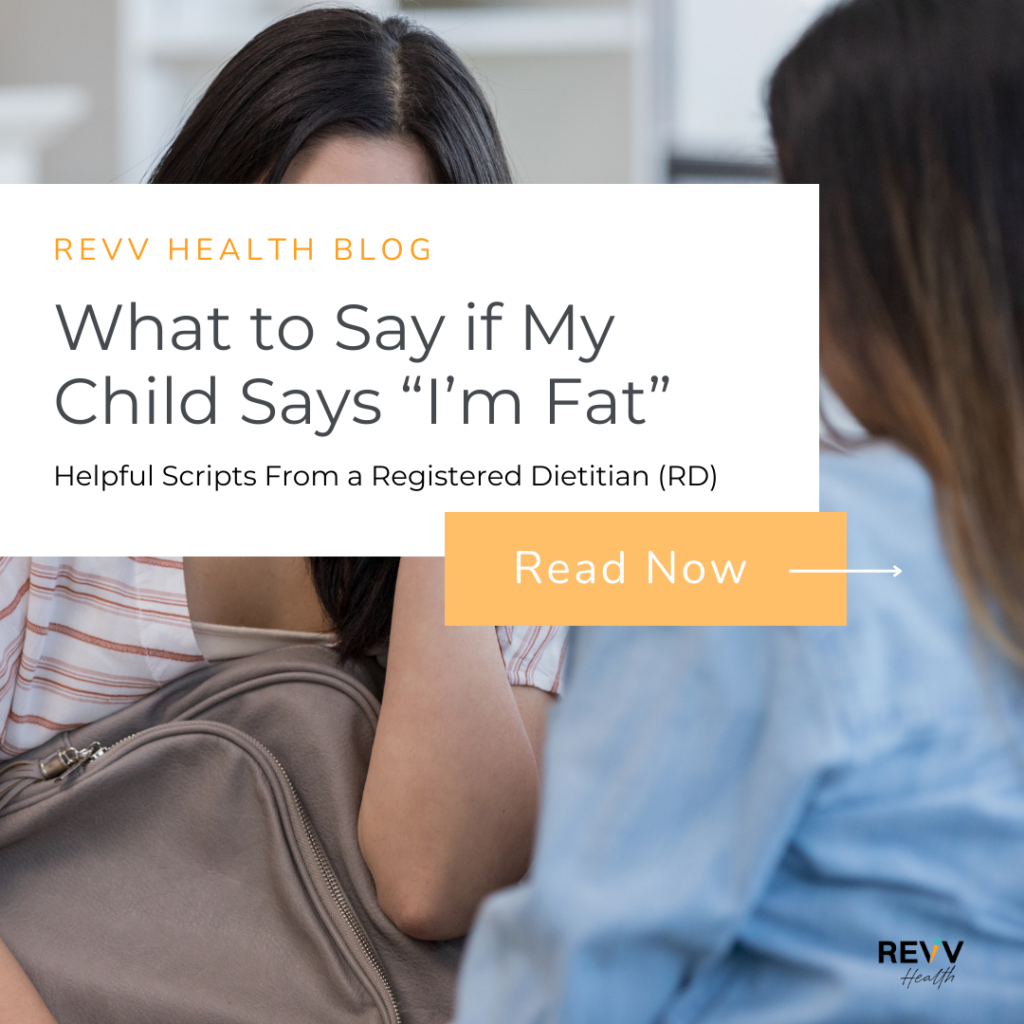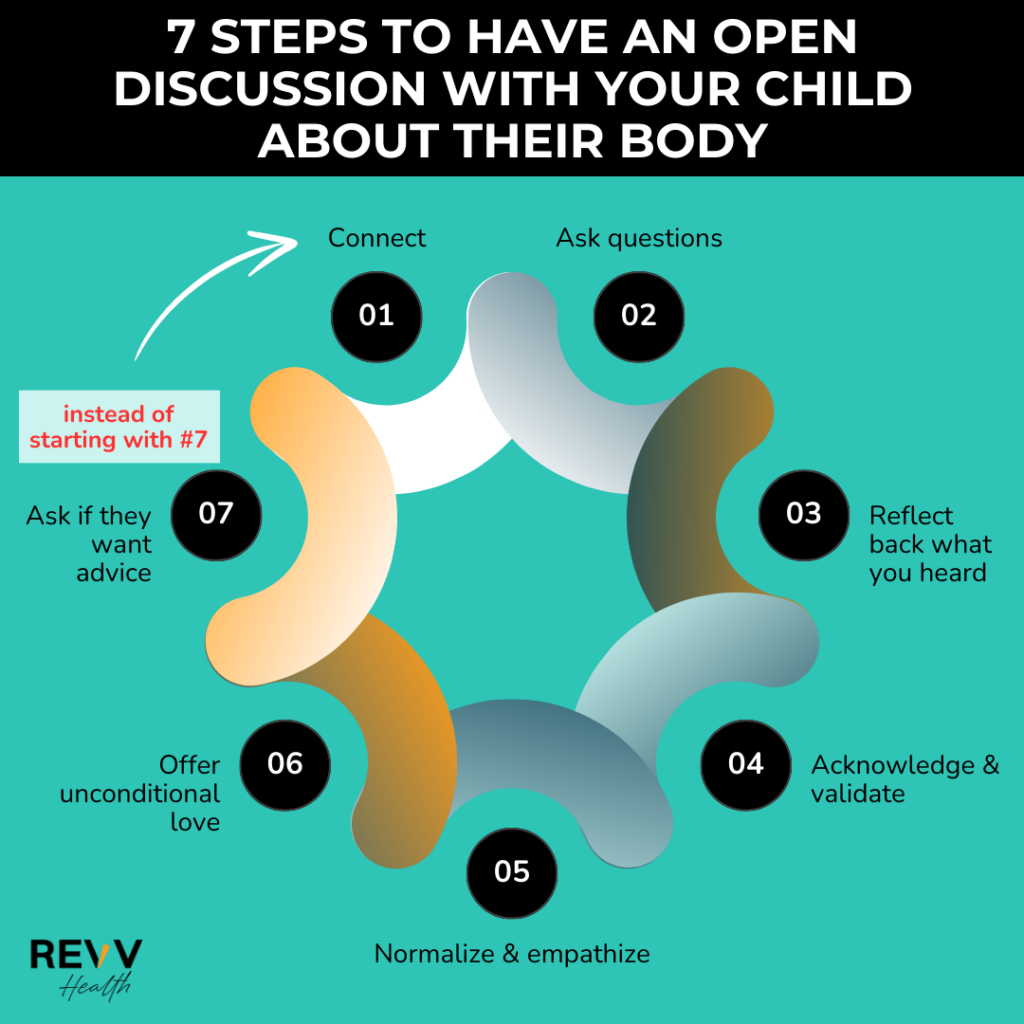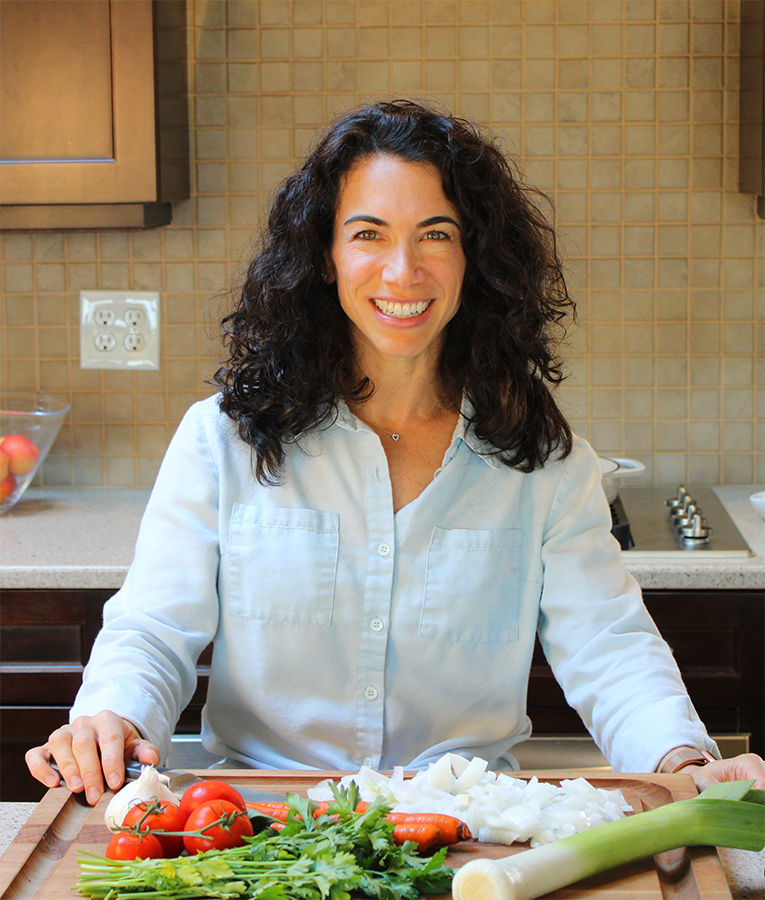A mom-friend of mine told me recently that her six-year-old daughter shared the words, “I’m fat,” and asked for my advice about how I would respond.
Gulp.
She told her child what any caring parent might say, “You aren’t fat at all!” followed by, “You’re perfect as you are.”
My initial reaction? While well-intentioned, her response can inadvertently suggest that her child’s body size is “not right.”
Gosh – these situations, especially when you’re answering in the spur of the moment – can feel so dang tough. That’s why I’m so glad you’re reading this article – to give you thoughtful scripts to speak with your child in a way that is supportive and minimizes the chance that you say something that causes harm.
Hi! I’m Marissa, a weight-inclusive dietitian and nutrition coach for high-achievers—and of course, let’s not forget my most important title, MOM. Please make sure you just read “Moooooom” with four syllables.
Parents and caregivers play such a vital role in your children’s relationship with food and their bodies… for better or worse. No pressure, right?!
Good news: In this article, you’ll learn how to respond to your child when they label themselves as fat or say they “feel fat,” all from a weight-neutral perspective.
Brief overview: the grueling stats
Nowadays, children experience body dissatisfaction – which means that they might feel bad about their weight, shape, or certain body parts. This feeling can make them upset or worried and sometimes leads to problems like eating disorders or feeling bad about themselves – at an earlier age. A 2016 study by the Journal of Pediatrics found that children aged 9 to 14 were dissatisfied with their bodies.
This dissatisfaction increases the risk of developing eating disorders as they grow older. Yikes. This is why it is so important to have productive conversations with your child about their weight, health, size, and body image, no matter their age. These feelings might not be “just a phase” or something that they’ll outgrow on their own.
Why is this important? For one, the Journal of Child Psychology and Psychiatry reports that environmental factors, especially the sociocultural idealization of thinness, significantly contribute to the development of eating disorders. Even more concerning, a study in the International Journal of Eating Disorders found that weight concerns starting as early as age 5 can predict future weight struggles.
Beneath the words your child says
When your child says, “I’m fat,” it can be jarring to hear in our fatphobic, thin-centric society.
Whether they heard it from someone else or arrived at the conclusion on their own, I will help you connect deeper than just offering a “body positive” canned response, such as “You’re not fat; you’re beautiful.” The risk of an overly happy response is that it can make your child feel unseen and even invisible. I’ll explain everything as we go.
I’ve broken this article into two parts:
- Part A: offers background knowledge and tools before your conversation.
- Part B: focuses on the conversation with your child.
Part A: Before you connect with your child
This is my parent and caregiver checklist for important prep before these important conversations with your child.
1. Check your bias at the door
We all want our children to be free of body image concerns. But where does this even begin?
This might be hard to hear, but it starts with you.
Helping your child develop a healthy relationship with their body often starts with reflecting on your own attitudes and beliefs.
If you speak negatively about your own or anyone else’s weight and appearance, especially in front of your children, they will internalize these messages about which bodies are “good” and “acceptable.”
“Checking your bias at the door” is an expression I learned in my nutrition and counseling training. It means setting aside your preconceived notions and prejudices before discussing body size (or any other topic, for that matter).
Why is doing this useful?
Our personal biases about food and body impact how we talk about them. By reflecting on this, you can stay open-minded when discussing weight with your kids.
To help you get started, here are a few questions you can ask yourself:
- If I were to ask your child how you speak about your own body, what kinds of comments would they report back?
- Do you tend to be self-deprecating about your body?
- Do you often criticize other’s body shapes and sizes?
- Are you fearful about fat and having too much of it?
Reflecting on your own weight bias is a great first step.
While doing so, don’t forget to show yourself kindness, as you might also be influenced by societal pressure to look a certain way.
2. Know that everyone has fat!
You have fat, I have fat, and so do your children! And boy, is this a relief!
As a dietitian, I must emphasize that we simply NEED fat. While you’ve come here to learn about what to say to your child if they share, “I’m fat” or “I feel fat,” we also don’t want to forget the important role body fat plays.
Body fat is essential. Thankfully, we all have it, and some people naturally have more than others. That’s what having different body types is all about.
Fat provides energy, supports cell growth, protects our organs, and keeps us warm! To name a few functions.
Having this foundational knowledge about fat can help you approach conversations about different body shapes from a more informed and fact-based perspective.
3. Remember: fat is a body type – not a feeling
While “fat” is technically a descriptor of body size, many people, including children, use it to express a mix of feelings.
For example, when your child says, “I feel fat,” they might be expressing discomfort, insecurity, anxiety, or sadness about their body or appearance.
Understanding what’s behind their words helps you address their underlying feelings.
So how can you begin to help your kids articulate their feelings about all of this?
4. Every Body is a Good Body
This is my favorite thing to say in my own house.
“All bodies are good bodies.”
If you can come at it from this particular lens, it will help you respond in a neutral way when your child shares body image issues.
As I like to tell my own kids, “People come in all shapes and sizes, and that is not only okay – but something we celebrate.”
When we view all bodies as inherently valuable and worthy of respect, we create a supportive environment where children feel accepted and valued regardless of their size or appearance.
This is where you can have a real impact:
- Instead of reinforcing negative stereotypes, you can affirm the uniqueness and beauty of your child’s body.
- You can help your child develop a positive self-image and encourage them to embrace their bodies with confidence and self-love.
- You can even decide as a family to be critical together of society’s unrealistic beauty ideals.
- You can teach your kids how to stand up and reject harmful societal standards that promote body shaming and discrimination.
By embracing body diversity, you can teach children to appreciate the uniqueness of every body.
Ultimately, if we promote the idea that every body is a good body, we can help kids embrace whatever body they have AND respect the diversity of others!
And isn’t that what we want: where all individuals are valued for who they are, regardless of their size or appearance?
5. Acknowledge that these conversations are tough
Talking about body image with your child can be incredibly challenging.
It is completely normal to feel unsure or worried about saying the right thing. Be gentle with yourself; it’s okay to not have all the answers.
These discussions might be tough, but they are also opportunities to strengthen your relationship with your child and to promote a positive and healthy self-image.
Your support and love are the most powerful tools you have in helping your child build confidence and resilience.
Part B: What to say in the moment
Now that you understand your own weight bias, the function of fat, how fat is a body type rather than an emotion, and last but not least, how every body is a good body, let’s discuss how you can respond thoughtfully.
Below are 7 practical steps, which I’ve listed in order so that you can confidently discuss your child’s feelings about their body.
1. Connect
If your child is willing to talk, you can become a much-needed vessel for sharing.
You can start with:
- “I’m really glad you told me how you’re feeling.”
- “Thank you for sharing that with me. I’m here to listen.
- “I hear you, and your feelings are important to me.”
- “Let’s sit down together and talk about this. I’m here to help.”
- “It’s brave of you to share your feelings. I’m here to listen.”
2. Ask questions
Even if their words make you feel uncomfortable, welcome their sharing with curiosity.
Pretend you’re a master detective:
- “What has been making you feel this way?”
- “Can you tell me more about those thoughts?”
- “When you say you ‘feel fat,’ what does that mean to you?”
- “Did anything happen today that made you feel this way?”
- “I want to understand more of what you’re going through. Can you tell me more about how you’re feeling and what might have led to these thoughts?”
3. Reflect back what you heard
After you ask questions, it’s okay for there to be a little silence. Let your child think and share.
Then, reflect back what you heard:
- “I see; you heard someone say that to you.”
- “I understand, you’re noticing your clothing is fitting differently now.”
- “Hmm, sounds like you see some changes in your body.”
- “Someone thought it was a not-so-funny insult.”
As hard as it is, reacting too quickly can unintentionally deny your child the ability to process their emotions (which they will do with you right away in step 4).
4. Acknowledge & validate
If you can understand the feelings behind your child’s words, you will be so much more equipped to respond in a meaningful way.
As Magda Gerber, a world-renowned childhood therapist, said, “Acknowledge and label feelings.”
In other words, “name it to tame it.”
This expression is a parenting tool I love from one of my all-time favorite books by Dr. Dan Siegel and Tina Payne Bryson called “The Whole Brain Child.”
It can go something like this:
- “I can tell this really upset you.”
- “You’re really bothered by this, aren’t you.”
- “It’s okay to feel mad.”
- “You look sad.”
- “It can be hard when we aren’t happy about our bodies.”
Let them share whether or not you “named it.” They might say, “No, I don’t feel sad, I feel mad!”
Keep being curious.
5. Normalize & empathize
Now that you’ve validated how they feel, let them know they aren’t alone in their feelings.
- “It’s perfectly normal to feel mad about this.”
- “I understand – that would make me upset, too.”
- “It can be really hard to have those difficult feelings.”
6. Offer unconditional love
Now, it’s time to share your feelings.
- “As you know, in our family, we believe all bodies are good bodies no matter what.”
- “I want you to know that you are lovable, worthy, special, beautiful, and fantastic, regardless of your size.”
- “I think you are unique and beautiful just as you are. Don’t let those negative thoughts make you forget that.”
7. Ask if they want advice
Sometimes, you might want to say more, but it can start to feel a little “preachy.”
Ask if it’s okay, “Mind if I give you a piece of advice?”
If they are open to it:
- “We all have an inner critic that sometimes tells us things that aren’t true or helpful.”
- “The good news is that we always have the choice to listen or not listen to our inner critic.”
- “Instead, we can focus on how special and capable we are.”
- “You can thank your inner critic for protecting you and then tell it, ‘I choose to love my body because it allows me to do wonderful things like [feel free to share any specific activity your child enjoys, like running, drawing, reading, etc.].”
What if my child has body image issues?
After having conversations with your child, you might feel like there is more going on.
If you hear his deeper fear of being fat or sense that your child has a negative body image, it might be time to seek more support.
To get started, I have a great article that can help you spot early warning signs of disordered eating, as it goes into detail about the differences between disordered eating and eating disorders.
Having open, supportive conversations can help you address these challenges early on.
What if my child is overweight? Isn’t this unhealthy?
Here’s the thing, weight, or even Body Mass Index (BMI), does not provide a complete picture of health.
Instead, I prioritize restoring overall health indicators, such as eating habits, vital signs, and energy levels, before considering weight as an indicator of improvement. I’d rather focus on behaviors such as:
- Eating fruits and veggies
- Typical sleep routine
- Managing stress
Reminder: weight is NOT a behavior!
Rather than fixating solely on weight, I believe it is more useful to monitor growth and development over time and take note of many different behaviors, not just the number on the scale.
What if my child desires weight loss?
If your child expresses a desire for weight loss, you will want to approach the situation with the utmost sensitivity and care.
Just like in the scripts offered here, start by listening attentively to your child’s concerns and desires.
Validate their feelings and reassure them that you are there to support them in a healthy and positive way.
Explore their motivation. Why do they want weight loss? This could stem from various factors such as societal influences, peer pressure, or personal health concerns. Open dialogue can help uncover their motivations.
Then, here are some real questions to ask:
- Can your child choose foods that make their body feel good?
- Can your child focus on finding movement that they enjoy?
- Can your child cope without using food to make them feel better?
- Can you both focus on the damage society is doing to people to reach unrealistic beauty standards?
These are not easy conversations to have. This is why I recommend seeking professional guidance by consulting with a weight-inclusive registered dietitian nutritionist (RDN) who can provide evidence-based guidance and ensure that any approach you consider is safe and focused on your child’s well-being.
What if my child’s pediatrician recommends weight loss?
If your pediatrician is recommending weight loss, here’s how you might respond:
“As a parent/caregiver, my priority is fostering a positive relationship between my child and BOTH food and her body, which I believe is more valuable than solely emphasizing weight loss. I do not view BMI alone as a reliable measure of health. Might we shift our focus to more positive, less harmful messaging, especially when discussing body size in front of my child? I’m open to discussing her well-being in terms of what her body can achieve rather than solely focusing on her weight.”
– You can also reference this article, written by Marissa Beck, MS, RDN
Other than weight loss, you can shift the focus toward many other healthful and reliable behaviors, such as:
- Supporting your child to try a variety of foods and flavors
- Ensuring they get enough enjoyable physical activity
- Getting adequate sleep and self-care
- Limiting screen time
- Coping with stress in effective ways
- Addressing emotional well-being with open, loving discussions on a daily basis
- Educating your community about inclusive and compassionate care that supports children’s overall health
Jessica Setnick, MS, RD, CEDRD, has a great article on her website about how to navigate a weight discussion with your pediatrician.
As a parent/caregiver, you have a right to advocate for your child, and you deserve to receive support that promotes a positive and sustainable approach to health.
Consider consulting with a weight-inclusive registered dietitian nutritionist (RDN), like myself, or another dietitian who can provide compassionate guidance tailored to your family’s needs.
We can help foster a nurturing environment focused on overall well-being rather than solely on weight, ensuring your child’s health journey is approached sensitively and with care.
Final words
You have more of an impact than you may think on your children’s internal dialogue about body fat.
I hope this article has given you a great start on how you can empower your kids to appreciate and respect their incredible bodies, no matter their size.
Remember that being compassionate with yourself will also help you model a healthier, more accepting attitude toward body diversity, which in turn can help your child develop a positive self-image.
Consider downloading my free “Every Body is Good Parent-Child Journal.” Sometimes, it is easier to have written conversations with your child, and there is space to reflect and draw, too.
Circle your favorite scripts from this article and use them as prompts to explore what you might say to support your child’s positive body image.
Your self-reflection can lead to meaningful conversations and foster a healthy relationship with body diversity. Plus, there is space to reflect on your own journey.
Ready to dive deeper? Download the journal and start your journey towards nurturing a positive self-image for both you and your child.







0 Comments